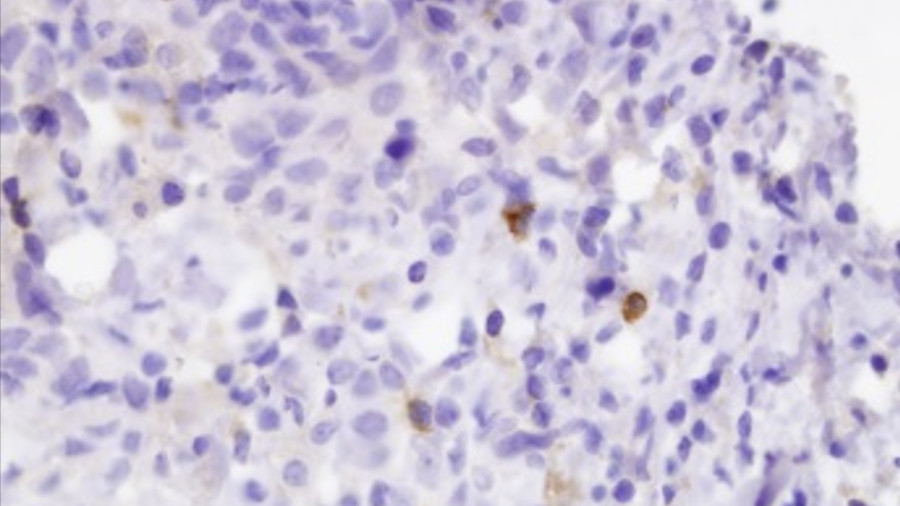Lymphocyte seen to "recruit" the immune system to fight most aggressive breast cancer
Researchers at the UAB and the Hospital del Mar Research Institute have confirmed that patients with the presence of NK lymphocytes around tumours have a better response to treatment. This confirms the feasibility of using cytokines secreted by NK cells as markers of response to treatment with a simple blood test and supports the use of these lymphocytes to reinforce treatment in patients with metastatic HER2-positive breast cancer.

A specific type of lymphocyte, the Natural Killers (NK), known for their anti-tumoural properties, are also capable, in combination with a treatment against the most aggressive form of breast cancer, to alert the immune system of the presence of cancer cells. This capacity allows theNK lymphocytes to recruit other immune system cells to join and fight against the tumour. This is certified by a study published in the Journal of Experimental & Clinical Cancer Research, which has also allowed researchers to describe a potential biomarker to identify patients having a positive response to the treatment.
The study was led by researchers from the Immunity and Infection Research Group of the Hospital del Mar Research Institute, Dr Aura Muntasell, who also lectures at the Universitat Autònoma de Barcelona, and PhD student Sara Santana. Also participating in the study were the Hospital del Mar Cancer Unit, directed by Dr Joan Albanell, the Hospital Clínic in Valencia, headed by Dr Juan Miguel Cejalbo, and the Hospital Universitario Virgen de la Victoria in Màlaga, led by Dr Emilio Alba. The Pathological Anatomy Services of the Hospital del Mar, with Dr Laura Comerma, and the Fundación Jiménez Díaz, with Dr Federico Rojo, also collaborated, as did the Scientific Research Network on Cancer (CIBERONC).
A tumour alert
Previous studies by the same group had confirmed the fact that the presence of Natural Killer cells, a type of cytotoxic lymphocyte that can kill tumour cells, in the setting of HER2-positive breast cancer tumours, was related to the patients' response to treatment with anti-HER2 anticoagulants. However, despite this association, their number was lower than that of other cells of the immune system, and therefore researchers suspected that they also had a regulatory role in the response of the body's defenses against cancer.
This new study focused on clarifying this aspect. From the comparison of the RNA set of biopsies of HER2-positive breast cancer tumours with and without the presence of NK cells, and of models with mice, the work has been able to demonstrate that these cells, when in contact with the antibodies used against these tumours, secrete two types of small proteins, cytokines, and other soluble factors. This modifies the tumour’s microenvironment, which in turn facilitates the arrival of other cells of the immune system, reinforcing the action of the treatment against cancer.
"Part of the effect of anti-HER2 antibodies is not only due to their intrinsic effect on tumour cells, but also to the fact that these antibodies allow, through NK cells, to trigger an antitumour immune response," explains Dr Muntasell. These conclusions were confirmed with the analysis of eighty samples. It was found that, in those with higher levels of Natural Killer cells, there was also a greater presence of lymphocytes with antitumour properties. In other words, they have the ability to alert the immune system and recruit other cells to target and eliminate cancer cells.
Dr Muntasell explains the mechanism involved in this process, pointing out that "the fact that there are NK cells in the presence of the anti-HER2 antibodies leads to an antitumour immune response. Therefore, NK lymphocytes not only have a direct antitumour function because they can kill transformed cells, but they also trigger this alarm that allows other cells of the immune system to reach the tumour and help eliminate it. In other words, they show the immune system where the tumour is so that it can fight it.
Potential new biomarker of treatment response
The study also analysed the possibility of detecting in patients, with a blood or serum test, the factors segregating natural killer cells when coming into contact with the treatment using anti-HER2 antibodies. Through serum samples of patients in treatment, their presence was confirmed in cases in which the person had had a positive response. “This new evidence suports the capacity of anti-HER2 therapy to bring on an immune response which is relevantly correlated with a greater therapeutic efficacy. This must serve to continue advancing in the improvement and personalisation of the treatment for patients with HER2 positive breast cancer”, says Dr Joan Albanell, head of the Hospital del Mar Cancer Unit, director of the Cancer Research programme of the Hospital del Mar Research Institute, and one of the autors of the study.
These discoveries validate the therapeutic strategies being developed at this moment, such as a clinical trial currently being conducted and led by the Vall d’Hebron Institute of Oncology (VHIO), with the involvement of Hospital del Mar, to transfer lymphocytes from a healthy donor into patients with HER2 positive metastatic breast cancer in combination with anti-HER2 antibodies, and in which the Clínica Universidad de Navarra and the Hospital Puerta de Hierro of Madrid also participate.
The researchers consider that these conclusions can be transferred to other types of tumours, since the study “proves that the NK lymphocyte activity as a cell capable of modifying the tumour’s environment is translatable to other tumours”, explains Dr Muntasell.
Original article: Santana-Hernández, S., Suarez-Olmos, J., Servitja, S. et al. NK cell-triggered CCL5/IFNγ-CXCL9/10 axis underlies the clinical efficacy of neoadjuvant anti-HER2 antibodies in breast cancer. J Exp Clin Cancer Res 43, 10 (2024). https://doi.org/10.1186/s13046-023-02918-4
The UAB, with Sustainable Development Goals
Good health and well-being